Proposals to carry out a conservation assessment at Wukro Cherkos, with a full training programme for recent graduates from Mekelle University and government bodies responsible for regional conservation work.
Introduction
In response to continued concerns about the condition of one of Tigray’s most well-known ancient rock churches, a partnership has been developed to progress further investigations at the church, including material testing, trial works, and comprehensive surveys of damp, salt levels, delamination of sandstone ceilings and walls and the preparation of a comprehensive record of the carved and painted decoration in the church. It is proposed that this work initiated by M Womersleys be carried out with postgraduate conservation, structural engineering, and tourism lecturers and students from within Tigray to build a skill base and reduce the likelihood of inappropriate interventions to this region's historic structures and buildings. This report sets out the significance of Wukros Cherkos Church and highlights its main issues, as climate change brings heavier periods of rain.
The Significance of the Church
The church, Figures ii and iii, has apparent similarities with Debra-Maryam within Gheralta, which Abbot Daniel reworked in the 13th century. Wukro Cherkos, thought to date to the eleventh century, is a similarly sizeable basilical plan form with four principal bays measuring in all 12 x 14 metres by over 5 metres high; there is also a narthex porch entrance of 4.5 metres square, see Figure i. It has a nave and two aisles, divided by columns carved out of the same solid rock excavated to form the church. The solid rock continues behind the Maqdas and the western internal elevation. The church's central aisle’s significance is marked by a barrel vault above the first two bays, rising from an Aksumite-inspired freeze and finishing in the final bay before the sanctuary with a cross carved out of the ceiling’s rock, defined by arches. The sanctuary has above its central bay a hollowed-out dome and beyond a semicircular apse surmounted by a half dome. The columns are carved in a cruciform and chamfered square plan with cushion and bracket capitals. The surrounding church walls are marked with pilasters that mark the bays. As at Debre-Maryam, the ceilings are carved to simulate wooden roofing techniques. The early church paintings are now partly exposed below later, sculptured and painted plasterwork, and must be some of the oldest in Tigray.
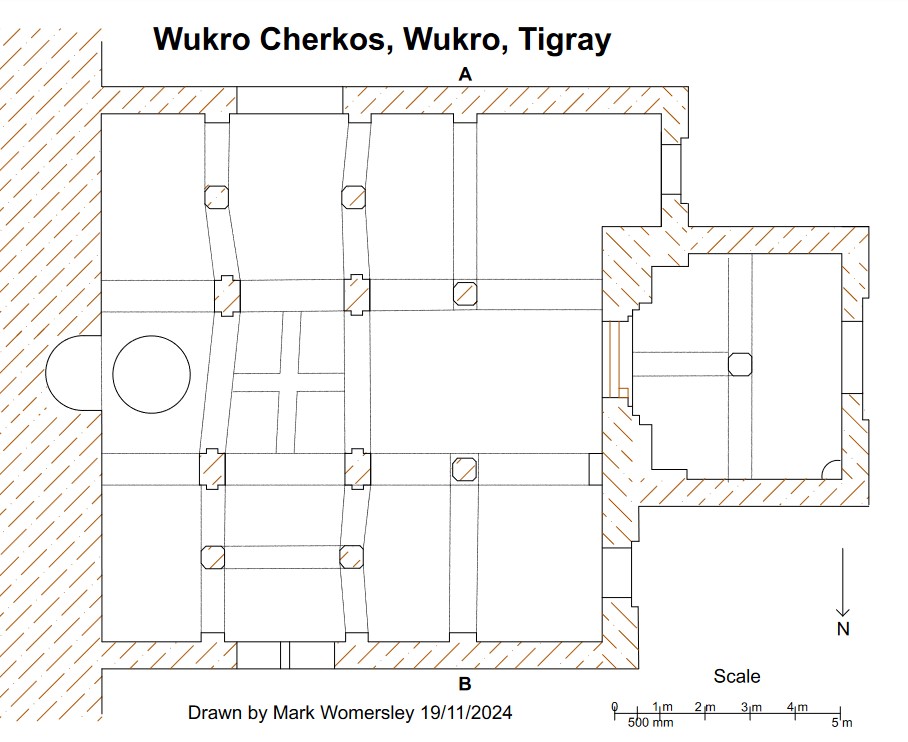
Figure i. Draft plan of Wukro Cherkos
 Figure ii. Draft north-south cross-section through Wukro Cherkos.
Figure ii. Draft north-south cross-section through Wukro Cherkos.

Figures iii & iv. The west front of Wukro Cherkos.
The issues which the research and investigatory work need to address
The issues are summarised in photos 1.1 to 11.3 below; they include the surface delamination of the stone, decorative finishes and thin coats of plaster, salt damage, water-borne staining and the root cause of most of the problems, water ingress through the rock walls into the inside ceiling and wall faces of the church. The programme will seek to build capacity within the University, Local Authority and Church Community to understand and deal sympathetically with the problems found in this and other rock churches in Tigray. The outputs from this project will be a detailed conservation plan, including a full record of the church's decorative stone detailing and paintings, a repair schedule, and a consultation document to seek approval from within the community for the repair proposals.

Figures v to viii. The Narthex, the south and the central aisles.

Figures ix to xi. The north aisle and the bay in front of the sanctuary.
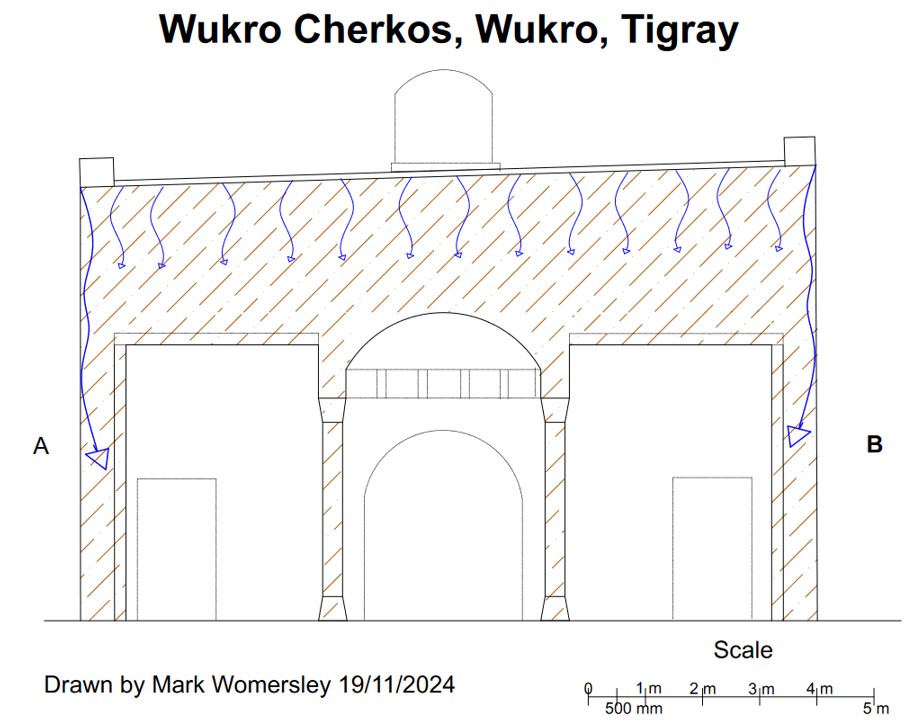
Figure xii. Apparent continued water ingress into the building, despite work twelve years ago to reduce this problem.

Figure xiii. The areas within the church whose problems are described in the illustrated photographic section below.


Figures 1.1 to 1.6. The narthex or porch is marked as area 1 in Figure xiii. The lighter areas on the ceilings indicate where later plaster is falling off, and large areas of sandstone have also delaminated on the ceilings and ribs. Staining is visible in the shallow arched niches above the entrance door to the external walls.

Figures 1.7 & 1.8. The later wall paintings below the geometric decoration are likely among some of the earliest paintings in Tigray.

Figures 1.9 to 1.92. The staining and salt damage within the porch is evidenced in the stained outer stone, which allow water to enter the solid rock cut walls.
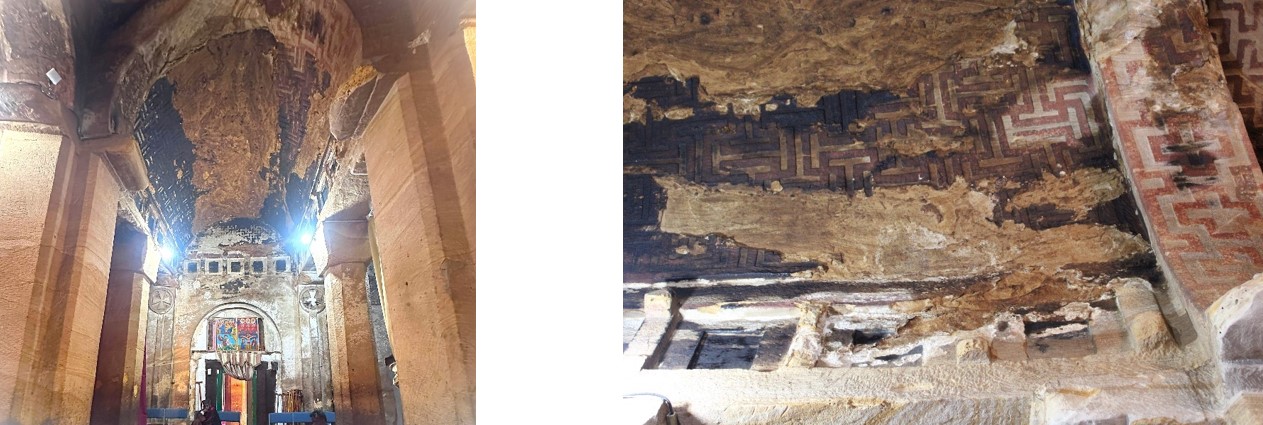

Figures 2.1 to 2.4 The barrel-vaulted first two bays of the church, marked as area 2 in Figure viii, have lost most of the low relief interwoven, straight-lined geometric decoration. Delaminating stone also extends to the Axumite-style freeze band and the wall above the entrance door.

Figures 3.1. The surface of the arches that define the third bay in front of the sanctuary, referenced as 3 in Figure viii, has also suffered severe surface delamination.
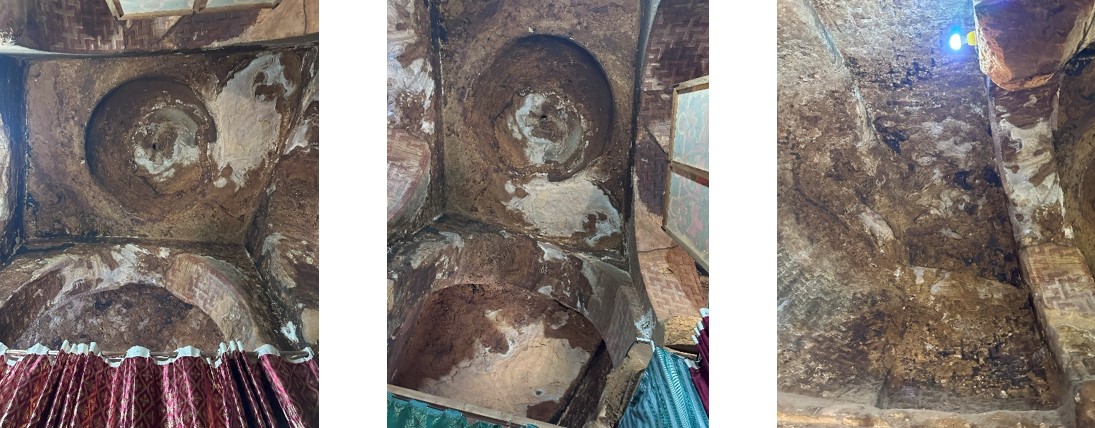
Figures 4.1 to 4.3. Above the central part of the maqdas, the highest areas are losing surface rock and finishes after previous and continuing water ingress.
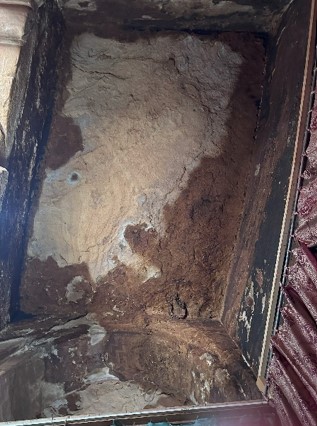
Figure 6.1. Similarly seen in the side chapels, area 6 in Figure viii.

Figures 7.1 to 7.4. The south aisle in area 7 on Figure viii has suffered water ingress through the core of the wall, which is visible above the window head and in the efflorescence that coats the frieze and arches.


Figure 7.5 to 7.8. The south aisle in area 7 on Figure viii has suffered water ingress through the wall's core, which is visible externally in the friable and salt-laden sandstone rock surface.

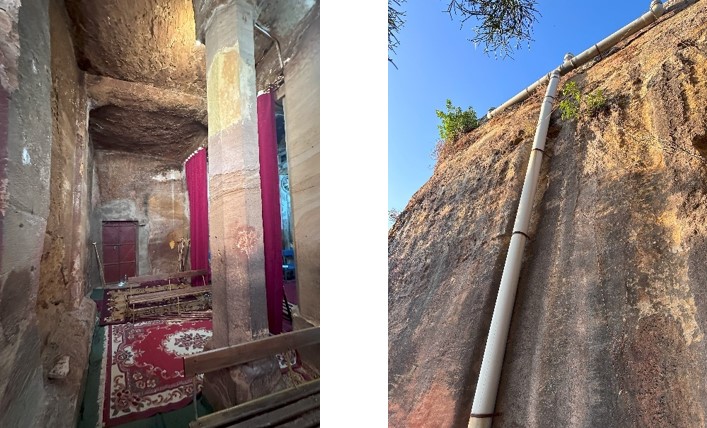
Figures 8.1 to 8.6. Salt damage and extensive deep sandstone delamination in the south aisle, see area 8 in Figure viii. With visible water staining to the rock face walls externally, despite the drainage above.

Figures 9.1 & 9.2. Reference 9 in Figure viii, the east end of the north aisle with surface delamination of sandstone and decorative details.

Figures 10.1 to 10.3. The southern aisle, former limewash coatings, further water-based erosion, and material breakdown.

Figures 11.1 to 11.3. The stone flags installed on the roof, parapets, and drainage spouts to take the water off the roof have been only partially successful at keeping the water out of the building and have reduced evaporation from the rock below.
Related Articles
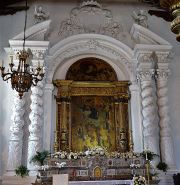
On Sunday, March 16th, why not come for a full introduction to lime plastering and a practical demonstration workshop?
Learn more about traditional clay, lime, and ornamental gypsum plasters and their use internationally…

Report on the support given by M Womersleys to Jabir Mohamed at Berbera Museum, Berbera, Somaliland, over two weeks from the end of October 2024
Contents …

Analysis of Building Mortars from the Famous Lister Mill Chimney in Bradford
M. Womersleys has recently completed a mortar analysis of several samples collected from the iconic …